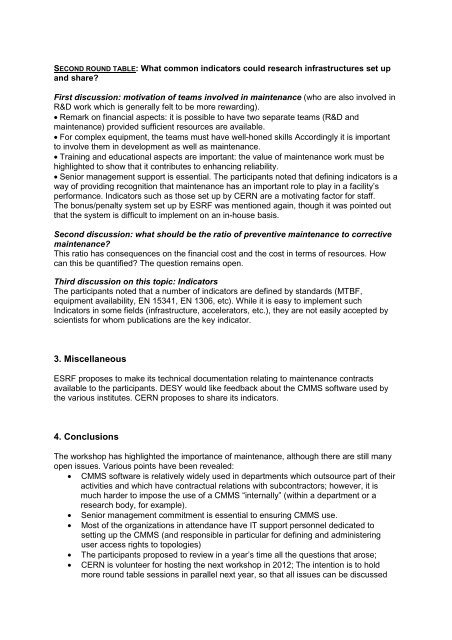Document - european association of national research facilities
Document - european association of national research facilities
Document - european association of national research facilities
Create successful ePaper yourself
Turn your PDF publications into a flip-book with our unique Google optimized e-Paper software.
SECOND ROUND TABLE: What common indicators could <strong>research</strong> infrastructures set up<br />
and share?<br />
First discussion: motivation <strong>of</strong> teams involved in maintenance (who are also involved in<br />
R&D work which is generally felt to be more rewarding).<br />
• Remark on financial aspects: it is possible to have two separate teams (R&D and<br />
maintenance) provided sufficient resources are available.<br />
• For complex equipment, the teams must have well-honed skills Accordingly it is important<br />
to involve them in development as well as maintenance.<br />
• Training and educational aspects are important: the value <strong>of</strong> maintenance work must be<br />
highlighted to show that it contributes to enhancing reliability.<br />
• Senior management support is essential. The participants noted that defining indicators is a<br />
way <strong>of</strong> providing recognition that maintenance has an important role to play in a facility’s<br />
performance. Indicators such as those set up by CERN are a motivating factor for staff.<br />
The bonus/penalty system set up by ESRF was mentioned again, though it was pointed out<br />
that the system is difficult to implement on an in-house basis.<br />
Second discussion: what should be the ratio <strong>of</strong> preventive maintenance to corrective<br />
maintenance?<br />
This ratio has consequences on the financial cost and the cost in terms <strong>of</strong> resources. How<br />
can this be quantified? The question remains open.<br />
Third discussion on this topic: Indicators<br />
The participants noted that a number <strong>of</strong> indicators are defined by standards (MTBF,<br />
equipment availability, EN 15341, EN 1306, etc). While it is easy to implement such<br />
Indicators in some fields (infrastructure, accelerators, etc.), they are not easily accepted by<br />
scientists for whom publications are the key indicator.<br />
3. Miscellaneous<br />
ESRF proposes to make its technical documentation relating to maintenance contracts<br />
available to the participants. DESY would like feedback about the CMMS s<strong>of</strong>tware used by<br />
the various institutes. CERN proposes to share its indicators.<br />
4. Conclusions<br />
The workshop has highlighted the importance <strong>of</strong> maintenance, although there are still many<br />
open issues. Various points have been revealed:<br />
• CMMS s<strong>of</strong>tware is relatively widely used in departments which outsource part <strong>of</strong> their<br />
activities and which have contractual relations with subcontractors; however, it is<br />
much harder to impose the use <strong>of</strong> a CMMS “internally” (within a department or a<br />
<strong>research</strong> body, for example).<br />
• Senior management commitment is essential to ensuring CMMS use.<br />
• Most <strong>of</strong> the organizations in attendance have IT support personnel dedicated to<br />
setting up the CMMS (and responsible in particular for defining and administering<br />
user access rights to topologies)<br />
• The participants proposed to review in a year’s time all the questions that arose;<br />
• CERN is volunteer for hosting the next workshop in 2012; The intention is to hold<br />
more round table sessions in parallel next year, so that all issues can be discussed


